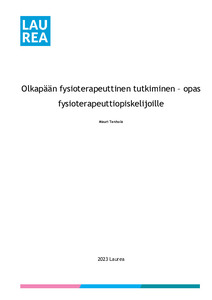Olkapään fysioterapeuttinen tutkiminen: opas fysioterapeuttiopiskelijoille
Tenhola, Mauri (2023)
Tenhola, Mauri
2023
All rights reserved. This publication is copyrighted. You may download, display and print it for Your own personal use. Commercial use is prohibited.
Julkaisun pysyvä osoite on
https://urn.fi/URN:NBN:fi:amk-2023102227804
https://urn.fi/URN:NBN:fi:amk-2023102227804
Tiivistelmä
Olkapään kipu tai siihen liittyvät ongelmat ovat yleinen tuki- ja liikuntaelimistön ongelma, jonka vuoksi hakeudutaan hoitoon. Kliininen tutkiminen on tärkeä osa olkapään fysioterapiaa, sillä usein vastaanotolla tehtyjä kliinisiä testejä voidaan hyödyntää myös kuntoutukseen käytettävinä harjoitteina. Olkapään fysioterapeuttinen tutkiminen koostuu asiakkaan haastattelusta, havainnoinnista eli inspektiosta, rakenteiden palpoinnista, liikkuvuuksien ja lihasvoimien mittauksista sekä erilaisista tarkentavista provokaatiotesteistä, joita suoritetaan tarpeen mukaan antamaan fysioterapeutille lisätietoa asiakkaan olkapään oireen syystä. Olkapään rakenteiden eristäminen eri kliinisten testien aikana on kuitenkin haastavaa olkapään monimutkaisen anatomisen rakenteen vuoksi ja tämä heikentää useiden testien tarkkuutta ja luotettavuutta.
Tämän opinnäytetyön tarkoituksena oli kartoittaa uusimpaan tutkittuun tietoon perustuvia olkapään fysioterapeuttisia tutkimismenetelmiä. Työn tavoitteena oli tuottaa tiedonhaun perusteella fysioterapeuttiopiskelijoille opas olkapään fysioterapeuttisesta tutkimisesta. Tämän toiminnallisen opinnäytetyön toimeksiantajana toimi Laurea AMK. Opas käsittelee olkapään fysioterapeuttisen tutkimisen etenemistä sekä tutkimiseen hyödynnettäviä kliinisiä testejä. Opas toteutettiin yhdistämällä kirjalliseen oppaaseen videomateriaalia.
Tämänhetkisen tutkimustiedon perusteella vaikuttaisi siltä, että olkapään rakenteita testaavat yksittäiset kliiniset testit eivät ole riittävän spesifejä tai tarkkuudeltaan riittäviä paikantamaan olkapäävaurion sijaintia. Yhdistelemällä olkapään tutkimuksessa samaa patologiaa tutkivia kliinisiä testejä, voidaan mahdollisesti kuitenkin lisätä kliinisen tutkimisen vaikuttavuutta. Eri olkapään kliinisten testien vaikuttavuudesta on tällä hetkellä ristiriitaista tutkimusnäyttöä ja joissain tutkimuksissa kliinisellä tutkimisella on tehty samoja löydöksiä kuin kuvantamistutkimuksella ja artroskopiassa. Olkapään kliiniseen tutkimiseen käytettävien fysioterapiamenetelmien luotettavuutta ja tarkkuutta tulisi tutkia lisää, jotta olkapään fysioterapeuttisesta tutkimisprosessista saadaan vaikuttavampaa ja standardoidumpaa.
Asiasanat: olkanivelen toiminta, olkapään fysioterapeuttinen tutkiminen, olkapään tyypilliset vaivat Shoulder pain or shoulder related problems are a common problem of the musculoskeletal system, for which treatment is sought. Clinical examination is an important part of shoulder physiotherapy, as clinical tests often can also be used as exercises for rehabilitation. Physiotherapeutic examination of the shoulder consists of interviewing the client, inspection, palpation of shoulder structures, measurements of mobility, muscle strength tests and various specific provocation tests, which are performed as needed to give the physiotherapist additional information about the cause of the client's shoulder symptom. However, the isolation of shoulder structures during different clinical tests is challenging due to the complex anatomical structure of the shoulder and this reduces the accuracy and reliability of many tests.
This functional thesis was commissioned by Laurea UAS and the purpose was to chart the physiotherapy methods used for clinical examination of the shoulder by utilizing the latest researched data. The goal of the thesis was to produce a guide for physiotherapy students on the physiotherapeutic examination of the shoulder. The guide discusses the progress of the physiotherapeutic examination of the shoulder and presents clinical provocation tests, which can be utilized for the examination of the shoulder. The guide was implemented by combining video material with the written guide.
Based on the current research data, it seems that the single clinical tests of the shoulder are not specific or accurate enough to locate the injured structure. However, by combining clinical tests which assess the same shoulder pathology, the effectiveness of the clinical examination can possibly be increased. There is currently conflicting research evidence on the effectiveness of different clinical tests for the shoulder, and in some studies the same findings have been made with clinical examination as with imaging and arthroscopy. The reliability and accuracy of the physiotherapy methods used for clinical examination of the shoulder should be further investigated in order to make the physiotherapeutic examination process of the shoulder more effective and standardized.
Keywords: function of the shoulder joint, physiotherapeutic examination of the shoulder, typical shoulder problems
Tämän opinnäytetyön tarkoituksena oli kartoittaa uusimpaan tutkittuun tietoon perustuvia olkapään fysioterapeuttisia tutkimismenetelmiä. Työn tavoitteena oli tuottaa tiedonhaun perusteella fysioterapeuttiopiskelijoille opas olkapään fysioterapeuttisesta tutkimisesta. Tämän toiminnallisen opinnäytetyön toimeksiantajana toimi Laurea AMK. Opas käsittelee olkapään fysioterapeuttisen tutkimisen etenemistä sekä tutkimiseen hyödynnettäviä kliinisiä testejä. Opas toteutettiin yhdistämällä kirjalliseen oppaaseen videomateriaalia.
Tämänhetkisen tutkimustiedon perusteella vaikuttaisi siltä, että olkapään rakenteita testaavat yksittäiset kliiniset testit eivät ole riittävän spesifejä tai tarkkuudeltaan riittäviä paikantamaan olkapäävaurion sijaintia. Yhdistelemällä olkapään tutkimuksessa samaa patologiaa tutkivia kliinisiä testejä, voidaan mahdollisesti kuitenkin lisätä kliinisen tutkimisen vaikuttavuutta. Eri olkapään kliinisten testien vaikuttavuudesta on tällä hetkellä ristiriitaista tutkimusnäyttöä ja joissain tutkimuksissa kliinisellä tutkimisella on tehty samoja löydöksiä kuin kuvantamistutkimuksella ja artroskopiassa. Olkapään kliiniseen tutkimiseen käytettävien fysioterapiamenetelmien luotettavuutta ja tarkkuutta tulisi tutkia lisää, jotta olkapään fysioterapeuttisesta tutkimisprosessista saadaan vaikuttavampaa ja standardoidumpaa.
Asiasanat: olkanivelen toiminta, olkapään fysioterapeuttinen tutkiminen, olkapään tyypilliset vaivat
This functional thesis was commissioned by Laurea UAS and the purpose was to chart the physiotherapy methods used for clinical examination of the shoulder by utilizing the latest researched data. The goal of the thesis was to produce a guide for physiotherapy students on the physiotherapeutic examination of the shoulder. The guide discusses the progress of the physiotherapeutic examination of the shoulder and presents clinical provocation tests, which can be utilized for the examination of the shoulder. The guide was implemented by combining video material with the written guide.
Based on the current research data, it seems that the single clinical tests of the shoulder are not specific or accurate enough to locate the injured structure. However, by combining clinical tests which assess the same shoulder pathology, the effectiveness of the clinical examination can possibly be increased. There is currently conflicting research evidence on the effectiveness of different clinical tests for the shoulder, and in some studies the same findings have been made with clinical examination as with imaging and arthroscopy. The reliability and accuracy of the physiotherapy methods used for clinical examination of the shoulder should be further investigated in order to make the physiotherapeutic examination process of the shoulder more effective and standardized.
Keywords: function of the shoulder joint, physiotherapeutic examination of the shoulder, typical shoulder problems
